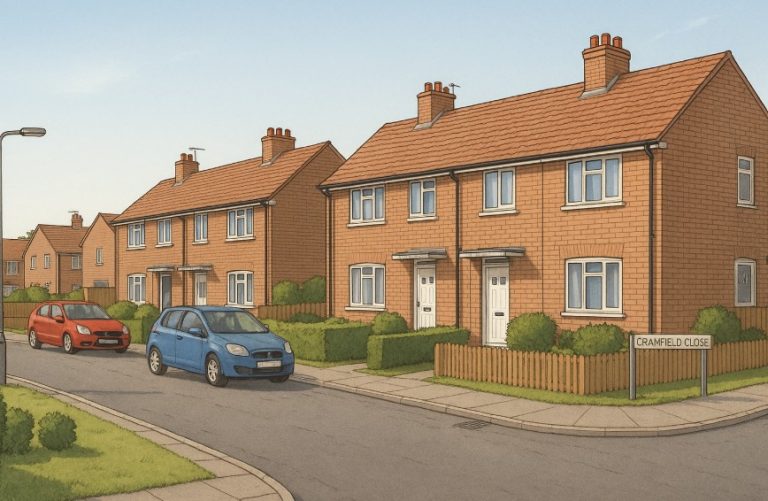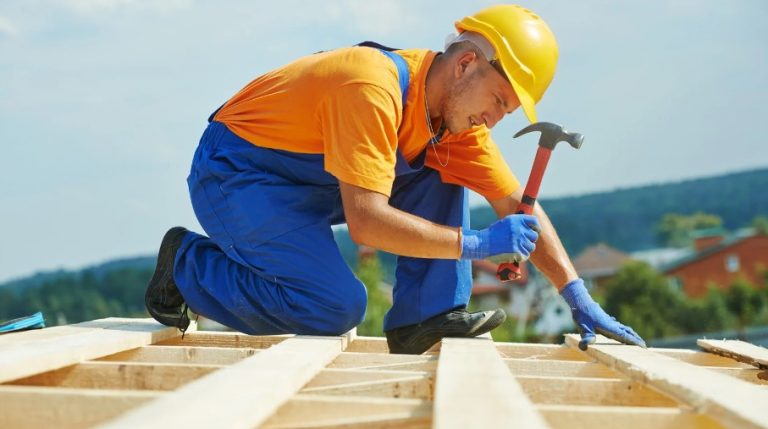The UK government has announced a transformative housing initiative that will see up to 40,000 new homes built on surplus brownfield railway land.
Targeted at first-time buyers, this plan aims to address the growing housing shortage while regenerating disused urban spaces.
Led by the newly established development company Platform4, the project promises sustainable, well-connected communities.
With a focus on major cities like Manchester, Newcastle, Nottingham, and Cambridge, this initiative marks a significant step in solving England’s housing crisis.
What Is the Government’s New Housing Initiative for First-Time Buyers?

The UK government’s latest housing scheme focuses on repurposing unused railway land to provide up to 40,000 new homes for first-time buyers across England.
The programme aims to meet critical demand in the housing market by delivering 15,000 of these homes within the next five years, contributing toward the government’s target of building 1.5 million homes by 2030.
This scheme responds to the growing concern over housing affordability, particularly for younger generations and low-to-middle-income households.
With the cost of living rising and the property ladder increasingly out of reach, this initiative is intended to bring well-located and accessible housing options within closer reach of first-time buyers.
A key component of the plan is the establishment of a new development company called Platform4, designed to fast-track land development, streamline government operations, and generate both public and private sector investment into housing.
How Will Brownfield Railway Land Be Transformed Into New Communities?
Brownfield railway land presents a strategic solution to the UK’s housing shortage. These sites, which once served rail operations or industrial use, have long remained underutilised.
With the introduction of Platform4, these dormant areas are set to be reimagined as vibrant, sustainable communities offering housing, amenities, and green space. The transformation involves not just construction, but comprehensive planning, remediation, and community integration.
Identifying and Prioritising Development Sites
The first step in transforming brownfield land involves identifying which plots are most viable for housing. This includes:
- Assessing proximity to transport hubs and city centres
- Evaluating the existing condition of the land
- Determining local housing demand and planning constraints
Sites such as the Forth Goods Yard in Newcastle and Mayfield in Manchester were prioritised because they meet these criteria and offer potential for high-impact regeneration. Many of these sites are also located within growth corridors or redevelopment zones already supported by local councils.
Consolidating Land Ownership and Management
Historically, one of the major obstacles in developing railway land has been fragmented ownership and management. Some sites were held by Network Rail, while others were under the purview of London and Continental Railways Ltd. The merger of these two entities into Platform4 is a pivotal change.
With a single body now overseeing land management, decisions can be made more efficiently, duplication is avoided, and investment becomes more attractive to private developers. This streamlined structure allows for faster approvals, standardised processes, and better resource allocation.
Conducting Environmental Assessments and Land Remediation
Brownfield sites often carry legacy issues such as contaminated soil, derelict structures, and outdated utilities. These challenges must be addressed before construction can begin. Platform4 initiates:
- Environmental impact assessments (EIAs)
- Site surveys and contamination testing
- Decontamination and clearance procedures
The goal is to ensure that the land is safe for residential use and complies with local and national environmental standards. This phase is essential for public health, long-term sustainability, and project approval by planning authorities.
Designing Mixed-Use and Sustainable Neighbourhoods
The vision for these developments goes far beyond just building houses. Platform4’s projects aim to create mixed-use neighbourhoods that blend residential living with retail, leisure, and green space. The key design features include:
- Medium to high-density housing suitable for urban settings
- Commercial units for local businesses and startups
- Parks, cycle paths, and public squares to encourage outdoor activity
This approach not only improves quality of life but also reduces dependency on cars, fosters local employment, and builds community identity. The integration of smart technology and energy-efficient infrastructure is another hallmark of these designs.
Engaging Local Communities and Planning Authorities
Effective community engagement is a crucial part of the transformation process. Platform4 works with local councils, residents, and community groups to ensure developments align with the needs and character of each area. Public consultations help shape project plans, address concerns, and build public trust.
Planning applications are submitted in phases, often beginning with infrastructure and utilities before progressing to housing and commercial space. Local authorities retain an active role in reviewing these plans and guiding development in line with regional planning strategies.
Supporting Transport Connectivity and Urban Integration
One of the core benefits of railway land is its built-in connectivity. These sites are often adjacent to train stations or existing public transport routes, making them ideal for transit-oriented development.
Platform4 ensures that new homes are integrated into the wider urban landscape by:
- Enhancing nearby rail and bus services
- Creating pedestrian-friendly access routes
- Linking housing developments to employment centres and schools
By doing so, the developments reduce reliance on private vehicles and encourage the use of public transport, supporting broader environmental goals.
Attracting Investment and Enabling Future Growth
Private sector investment is fundamental to transforming brownfield land at scale. By unlocking land in key city locations, Platform4 makes it easier for developers, investors, and housing associations to commit long-term capital to these projects.
In return, investors gain access to:
- Valuable land in strategic urban locations
- Government-backed planning and infrastructure support
- A growing demand for affordable, centrally located housing
This model sets the foundation for future growth, allowing the government and its partners to replicate successes across additional sites throughout England.
What Is Platform4 and Why Was It Created?

Platform4 was launched by the government in July 2025 as a public property development company tasked with unlocking surplus railway land for large-scale housing development.
This new entity was formed by merging the property functions of London and Continental Railways Ltd with Network Rail’s property team, previously operating independently.
The merger addresses several inefficiencies that had plagued railway land development in the past.
Disparate management often resulted in slow decision-making, underutilisation of land, and missed opportunities for community regeneration. The consolidation into Platform4 aims to deliver housing projects at greater scale and speed.
The company has been structured to serve both a social and economic mission:
- Facilitate the disposal of surplus rail land for housing
- Attract private sector investment through streamlined planning
- Reinvest profits into the UK’s rail infrastructure
Financial projections show that the combined operations are expected to generate an additional £227 million in value over the next decade compared to past strategies.
Which Cities Will Benefit From the New Developments?
Initial developments are concentrated in major English cities where brownfield railway land is available and demand for housing is high. These sites are strategically chosen based on location, connectivity, and development potential.
Below is a breakdown of the first four cities and the number of homes planned:
| City | Development Site | Homes Planned | Additional Details |
| Manchester | Mayfield | 1,500 | Former goods yard, part of central regeneration |
| Newcastle | Forth Goods Yard | 600 | Early-stage housing plan with further expansion potential |
| Cambridge | Mixed-use redevelopment | 425 | Will include residential, retail and public space |
| Nottingham | Post-Barnum development | 200 | Follows a previous successful 348-home scheme |
These are the initial sites, but the project will expand to more locations across England in future phases, depending on land availability and planning processes.
How Will the Initiative Address the UK’s Housing Crisis?
The UK has long faced a shortfall in new homes, especially in areas where demand is growing rapidly. The housing crisis has led to inflated house prices, rental increases, and an overall strain on urban infrastructure.
This initiative targets those challenges by:
- Delivering homes in city centres and transport hubs, reducing pressure on outer suburbs
- Providing affordable options for first-time buyers through public-private funding models
- Replacing dormant or derelict land with usable, liveable space
By reintroducing vitality into urban areas, the plan also contributes to reducing homelessness, overcrowding, and excessive commuting distances.
In addition, building homes on brownfield land aligns with sustainability goals by reducing the need for greenbelt development and preserving agricultural land. These developments are expected to include energy-efficient designs, green roofs, and renewable energy integration wherever feasible.
What Role Will Private Sector Partnerships and Investment Play?

The success of this scheme heavily relies on effective collaboration between public and private stakeholders. Platform4 has been tasked with fostering strategic partnerships to ensure timely, cost-effective delivery of housing projects.
The private sector’s involvement is not just limited to construction. Developers, housing associations, and real estate investors are expected to contribute to design, planning, infrastructure development, and long-term community support.
Key partnerships announced so far include:
- Keepmoat: A national housebuilder focused on brownfield sites. Over 80% of its current projects are on previously used land, making it a natural collaborator for Platform4.
- Grainger plc: A major provider of private rental housing. Their partnership supports the inclusion of high-quality rental homes in the new developments.
- Home Builders Federation: Has publicly supported the scheme, citing its potential to meet urgent housing needs and boost economic growth.
- British Property Federation: Endorsed the creation of Platform4 as a mechanism for unlocking underused public assets and attracting private capital.
This public-private approach is expected to bring in over £350 million in private investment, which will accelerate delivery while reducing reliance on public funding.
What Are the Economic and Social Benefits of the Scheme?
Beyond the provision of housing, the redevelopment of railway land is positioned as a catalyst for wider economic growth. The government’s estimates suggest that over £1 billion in economic value could be generated through these developments.
The benefits are multi-layered and include:
- Job creation: Thousands of new roles in construction, retail, services, and public infrastructure
- Public realm improvement: Integration of green spaces, pedestrian areas, and community centres
- Transport integration: Homes built near rail lines will reduce road traffic and support low-carbon transport options
- Revenue reinvestment: Profits from Platform4 will be channelled into upgrading rail services and infrastructure
This regeneration model supports both short-term job creation and long-term economic sustainability. By encouraging growth around stations and transport corridors, the developments help create more balanced regional economies.
What Challenges Are Involved in Developing Railway Land?
Despite its potential, brownfield railway land comes with specific challenges. Development on such sites often involves higher upfront costs, complex permissions, and environmental remediation.
Some of the primary challenges include:
- Land contamination: Historical industrial use may have left pollutants that must be cleared before development
- Planning permissions: Navigating local regulations, environmental impact assessments, and public consultations can cause delays
- Access and transport: Sites may require new roads, paths, or upgrades to existing infrastructure to support new communities
To manage these risks, Platform4 works closely with local councils, planning authorities, and other government departments. It also leverages expertise from both the public and private sectors to ensure that developments are feasible and beneficial to local communities.
Who Are the Key Figures Behind This Housing Transformation?

The scheme has the support of top government officials and experienced industry leaders. Several key individuals are steering the initiative, combining political leadership with professional housing and regeneration expertise.
Heidi Alexander, Secretary of State for Transport, launched Platform4 and has championed the role of railway land in driving urban regeneration. She emphasised the vision of turning disused infrastructure into vibrant communities that serve working families.
Angela Rayner, Deputy Prime Minister and Housing Secretary, reaffirmed the government’s commitment to building homes in high-demand areas using a brownfield-first strategy. She stated that the initiative represents a turning point in the government’s effort to make housing more accessible.
Bek Seeley, appointed as Chair of Platform4, brings deep experience from her work with Lendlease and other regeneration projects across the UK. She is also the Chair of the Euston Housing Delivery Group and is expected to guide Platform4 with a focus on strategic planning, partnership development, and sustainable design.
These leaders are supported by private sector executives such as Ian Hoad of Keepmoat, Helen Gordon of Grainger plc, and Neil Jefferson from the Home Builders Federation, all of whom have expressed confidence in the potential of this initiative to change the landscape of urban housing in the UK.
Conclusion
By converting underutilised railway land into vibrant neighbourhoods, the government’s brownfield housing initiative offers real opportunities for first-time buyers across England. Platform4’s strategic approach brings public and private sectors together to deliver homes, infrastructure, and long-term community value.
This regeneration effort not only addresses housing shortages but also supports jobs, economic growth, and sustainable development. As thousands of new homes take shape, this initiative represents a promising solution to one of the UK’s most pressing challenges.
Frequently Asked Questions
What types of homes will be built on the brownfield railway land?
The developments will include a mix of homes suitable for families, individuals, and renters. Many will be affordable or built to support first-time buyers, with some projects also including rental housing and mixed-use developments.
Will the homes be located near transport links?
Yes, the homes are being developed on railway land, meaning they will be well-connected to major transport routes. This is expected to make commuting easier and support car-free or low-emission lifestyles.
What is Platform4’s funding model?
Platform4 will use a mix of public investment and private sector capital. Profits generated from land sales and development will be reinvested into the UK’s railway system and infrastructure upgrades.
How will the local environment be considered in these developments?
Sustainability is a core priority. Many sites will include green spaces, energy-efficient building designs, and improved local infrastructure. Regeneration aims to preserve and enhance the surrounding environment.
Will all 40,000 homes be delivered at once?
No. The delivery is phased over 10 years, with 15,000 homes expected in the first five years. This allows time for site preparation, planning, and partnership development.
What are the benefits for local communities?
Communities will benefit from job creation, enhanced amenities, improved connectivity, and new investment. The developments aim to integrate with existing neighbourhoods to support long-term social and economic uplift.
Can local councils get involved in the planning process?
Yes. Platform4 works closely with local authorities and public sector landowners to align housing delivery with local needs and planning frameworks.






